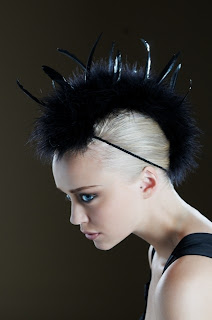This post is dedicated to my newly found millinery inspiration
Rebecca Coffee
What I find so striking about the first image is the clear links to Ethiopian culture as I was immediately put in mind of the tribal headdresses of the Omo Valley, as taken by Hans Silvester.
James Faulkner
The interesting yet controversial material of road kill in millinery.
Loren Anthony James-Wood
With a strong avian influence, this millinery style is a nod to the 'plume boom' where many birds were used whole in the making of hats.
Coconut
These two images headdresses/hats are both formed from coconut, the first of unknown origin and the other from Rarotonga, Cook Islands. I found them whilst sourcing imagery for my coconut collage for Art School Disco, finding the shapes and use of material particularly inspiring.
Noel Stewart
I think the success of Stewart's designs at such sizes is what appeals to me the most, that and the use of mussels in the headpiece below is genius!
Whole birds
These images are from tumblr so I have no idea where they originally came from, though they are a great demonstration of the fad that was stuffing and attaching whole birds.
Piers Atkinson
I've found that the right combination of the exotic, the fun, the alluring combined with a varnish of professionalism is apparent in Atkinson's work. Another vast array of of materials from which to draw inspiration from.
Ashley Lloyd
The macabre work of Ashley Lloyd is extremely in tune with my personal taste. Shrouded in mystery and shamanic influences, Lloyd uses materials that allow the hat to become one step further than an accessory towards an apparent human/animal mutation.
Riitta Ikonen
Though Ikonen's imagery is not entirely about the hat, there would be no photographs without this focal point. Forms such as ice, grass and seaweed have all been utilized in this form of hat making which of course solidifies the often recurring natural influence.
The following two images may not be hats yet are still extremely intriguing! Also by Riitta Ikonen.
What I find so striking about the first image is the clear links to Ethiopian culture as I was immediately put in mind of the tribal headdresses of the Omo Valley, as taken by Hans Silvester.
James Faulkner
The interesting yet controversial material of road kill in millinery.
Loren Anthony James-Wood
With a strong avian influence, this millinery style is a nod to the 'plume boom' where many birds were used whole in the making of hats.
Coconut
These two images headdresses/hats are both formed from coconut, the first of unknown origin and the other from Rarotonga, Cook Islands. I found them whilst sourcing imagery for my coconut collage for Art School Disco, finding the shapes and use of material particularly inspiring.
Noel Stewart
I think the success of Stewart's designs at such sizes is what appeals to me the most, that and the use of mussels in the headpiece below is genius!
Whole birds
These images are from tumblr so I have no idea where they originally came from, though they are a great demonstration of the fad that was stuffing and attaching whole birds.
Piers Atkinson
I've found that the right combination of the exotic, the fun, the alluring combined with a varnish of professionalism is apparent in Atkinson's work. Another vast array of of materials from which to draw inspiration from.
Ashley Lloyd
The macabre work of Ashley Lloyd is extremely in tune with my personal taste. Shrouded in mystery and shamanic influences, Lloyd uses materials that allow the hat to become one step further than an accessory towards an apparent human/animal mutation.
Riitta Ikonen
Though Ikonen's imagery is not entirely about the hat, there would be no photographs without this focal point. Forms such as ice, grass and seaweed have all been utilized in this form of hat making which of course solidifies the often recurring natural influence.
The following two images may not be hats yet are still extremely intriguing! Also by Riitta Ikonen.
















































No comments:
Post a Comment